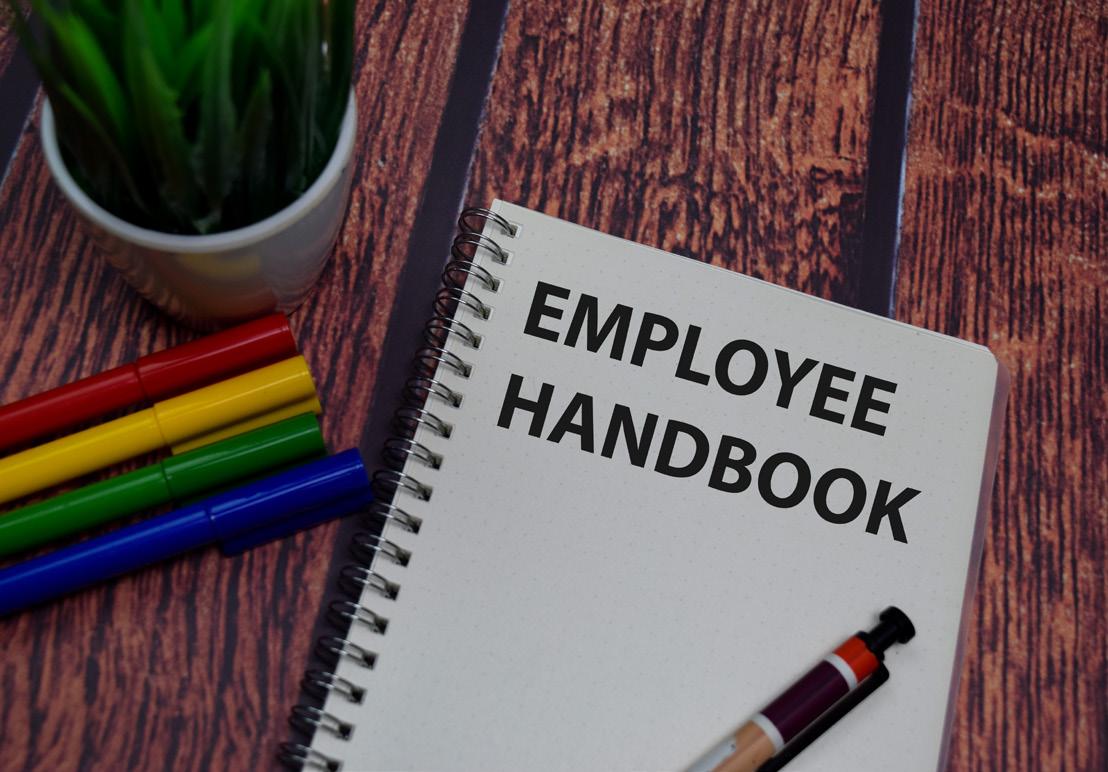
3 minute read
Human Resources Corner
by VIAA
HR CORNER
The Value of Employee Handbooks
Advertisement
This is a continuing article in series of
human resource articles for the “Independent Agent.” My goal is to bring value to your organization in accomplishment of the Essentials of Human Resources. In past articles, we have dealt with a variety of topics Based on my most recent sample in talking with various Independent Insurance Agents across the state, I am concerned that we do not have current handbooks in place for members of our workforces. As you are aware over time, things change like new federal, state and local labor regulations. The policies of your organization change. There is employee turnover in the organization. We need to be on top of our business; if we are not, it could be expensive to fix.
What does an Employee Handbook do for you?
An Employee Handbook is a compilation of the policies, procedures, working-conditions, compensation and benefits clarification, and behavioral expectations that guide employee actions in a particular workplace. In a handbook, these policies and procedures range from how to access your employee personnel file to your opendoor policy, your promotion policy to compliance like the American Disabilities Act, the Equal Employment Opportunity Commission’s policies and the Fair Labor Standards Act.
The handbook generally includes information about the company, a welcome from the President or Owner, mission, values statement, strategic goals, commitment to the workforce, non-compete and / or confidentiality statements. In addition, topics like attendance, closings, payroll, company property are discussed.
Employee Handbooks if properly done, maintained and executed are a great communication in understanding for both the employer and the workforce.
How do Employers Use an Employee Handbook?
Employers use Employee Handbooks to provide a consistent set of policies and procedures.
They also use handbooks to describe the working conditions and the workplace behavior and contributions they expect from employees. They believe that by putting forth a shared approach to addressing workplace issues, they have the best potential to create a harmonious, fair, employer supportive workplace.
Employers also use the policies in an Employee Handbook to provide the roadmap to ethical and legal treatment of employees. They protect themselves from lawsuits, such as harassment claims, wrongful termination claims, and discrimination claims. Employee Handbooks behaviors that will warrant disciplinary action up to and including termination in their workplace.
Employee Handbooks need to be updated as a whole every two years and communicated / distributed to employees. During the interim use a page revision system. Always make sure that you are communicating and updating employees on changes effectively and efficiently.


Based on my experiences with many employers over the years, please avoid the following
Top 10 mistakes in Employee Handbooks:
1. Adopting a “form” handbook which includes promises you’ll never keep. 2. Including lots of detail on procedures which provides fodder for lawyers. Stick to company policies. Kee a separate procedures manual for managers. 3. Not defining a probationary or introductory period could lead to complications and misunderstanding. Better to be proactive than reactive. 4. Being too specific in your discipline policy. That gives the impression that the list covers every possible infraction.
5. Not being consistent with other company documents.
6. Overlooking an at-will disclaimer. Have employees sign a disclaimer acknowledging that the company can terminate their employment at any time and by-pass discipline policies.
7. Sabotaging disclaimers by what you say, especially reassuring employees that their jobs are secure.
8. Not adapting the handbook to accommodate each state’s law. 9. Failing to update the manual frequently for changing laws and policies. 10. Setting unrealistic policies. If you know your supervisors won’t enforce it, don’t put it in your handbook.
So, my question is … where do you stand? Do you have an Employee Handbook? If not, you are at risk or embarrassment. It could be very costly to you. If you have one, when was the last time you updated it? If it has been over 2 years, it is probably out-of-date?
It is always best to be proactive versus being reactive. Better to invest a little for the future now than be exposed for a lot later.
If you have a question or need clarification, please contact Dave Nichols or a Human Resource or legal professional.
Dave Nichols is the principal of a human resource management business, Quality Transitions, Inc. located in Charlestown RI. He has 25 years of experience in the field and also retired from the U.S. Army as a Lieutenant Colonel. If you are interested in learning more, please visit his website at www.qualitytransitions.net.









